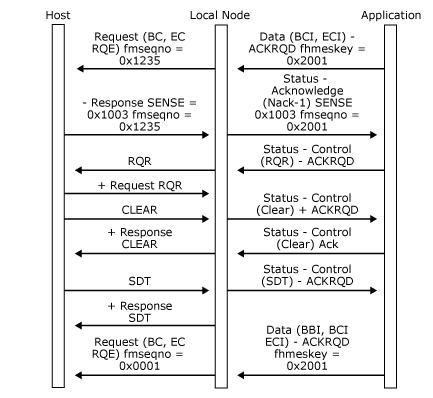RQR and CLEAR
An application using Transmission Service profile (TS profile) 4 can request the session to be recovered by sending Status-Control(RQR). The local node presents this to the host as an RQR request. Note that, if the application has received a critical Status-Acknowledge(Nack-2), this option cannot be taken because the local node will send a Close(PLU) Request immediately following the Status-Acknowledge(Nack-2) to the application, and the primary logical unit (PLU) connection will no longer be valid. The RQR message requests the host to reset the session by sending a CLEAR request, as shown in the following figure.
The receipt of CLEAR causes the application to reset its session state to that following the BIND, the Open(PLU).
Another way for the application to deal with error conditions is to ask for an UNBIND by sending Status-Control(RSHUTD). (For more information, see Application-Initiated Termination.) Note that this may not require the host to supply a new BIND, depending on the host configuration. A new SSCP request may be required (such as LOGON).
In the following figure, the application requests recovery by issuing Status-Control(RQR). The host sends CLEAR, and the application must reset its session to state that it was following the BIND (Open(PLU)). In this case, the application is now between brackets and awaiting start data traffic (SDT).

Application requests recovery by issuing Status-Control(RQR)
See Also
Application CANCEL
Direction after Receiving a Negative Response
Direction after Sending a Negative Response
Critical Failure
STSN
Link Service Failure
Local Node Failure
Client Failure